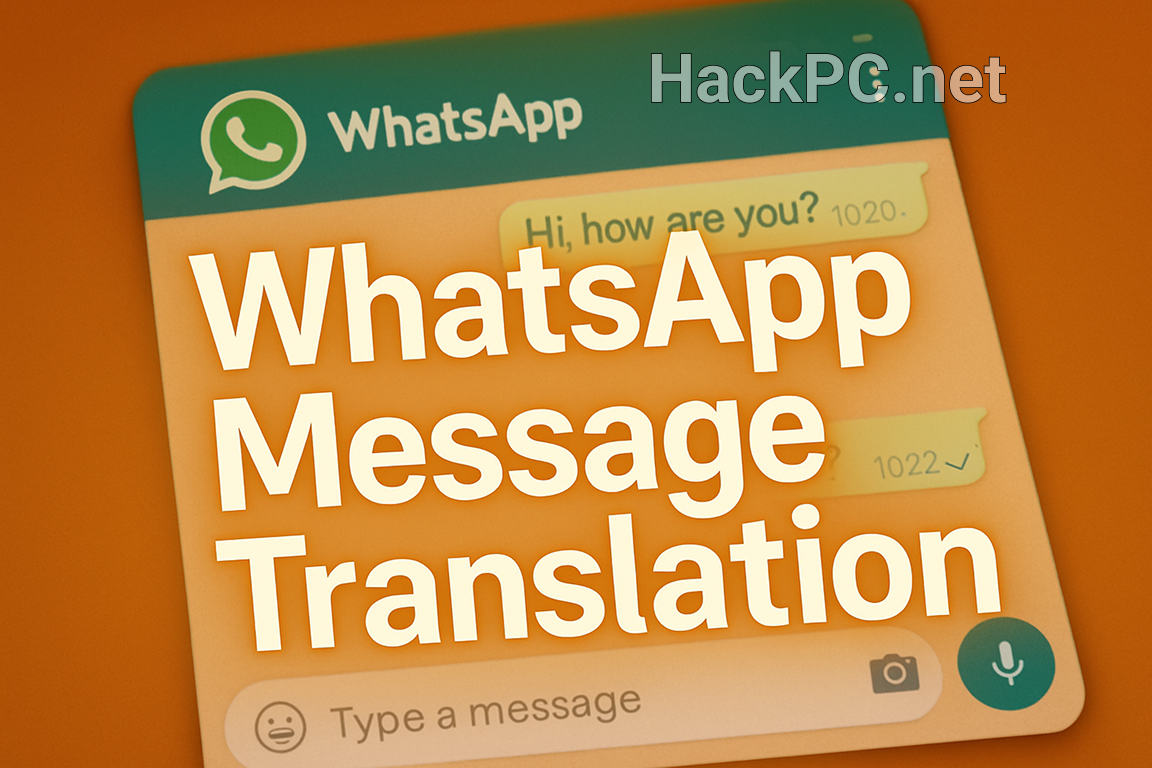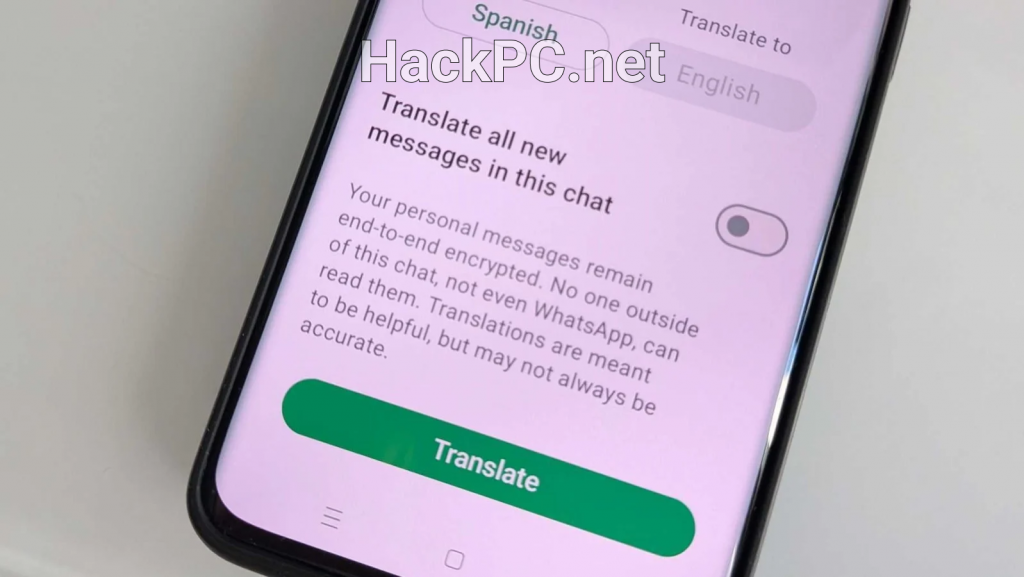
Three billion users across 180 countries just got a compelling reason to update their WhatsApp messaging app. The Meta-owned platform has rolled out its long-awaited built-in translation feature, fundamentally changing how we navigate multilingual conversations without compromising the end-to-end encryption that defines the platform’s security foundation.
The Technical Implementation: Privacy-First Architecture
WhatsApp’s approach to real-time translation reveals a carefully orchestrated balance between functionality and privacy protection. Unlike competitors who route translations through cloud servers, WhatsApp processes every translation locally on your device. This on-device translation means your private messages never leave your phone during the translation process, maintaining the integrity of WhatsApp’s end-to-end encryption protocol.
The mechanism is elegantly simple: long-press any message, tap the “Translate” option that appears in the context menu, and select your target language. The app downloads language packs directly to your device—averaging about 24 megabytes each—ensuring future translations occur instantly without network dependency. This architecture stands in stark contrast to Telegram’s translation implementation, which sends messages through Google’s servers for processing, potentially exposing conversation content to third-party infrastructure.
Platform Disparities: iOS Gets the Advantage
The rollout reveals an interesting disparity in cross-platform feature parity. iPhone users gain access to over 19 languages from day one, leveraging Apple’s robust Translate API to support everything from Mandarin Chinese and Japanese to Ukrainian and Vietnamese. The integration taps directly into iOS’s existing translation infrastructure, providing seamless language conversion for one-on-one chats, group conversations, and even WhatsApp Channel updates.
Android users face a more limited initial offering with just six languages: English, Spanish, Hindi, Portuguese, Russian, and Arabic. However, Android’s implementation includes an exclusive automatic translation feature that iOS users don’t receive—enabling entire chat threads to translate incoming messages automatically without manual intervention. This convenience feature transforms how Android users engage with international contacts, eliminating the repetitive action of translating each message individually.

Privacy Architecture vs. Competitive Landscape
The privacy-focused translation implementation highlights WhatsApp’s strategic positioning against competitors in the instant messaging translation space. While Telegram offers translation features that route through Google Translate’s infrastructure, WhatsApp’s commitment to on-device processing ensures even Meta cannot access translated content. This distinction becomes particularly relevant for business communications and sensitive personal conversations where data sovereignty remains paramount.
The technical achievement here shouldn’t be understated. Processing natural language translation entirely on mobile hardware requires sophisticated optimization and efficient language models. Each downloaded language pack contains the necessary neural network weights and linguistic databases to perform complex translation tasks without cloud assistance—a significant engineering accomplishment that maintains conversation privacy while delivering instant message translation capabilities.
Real-World Impact: Beyond Simple Translation
For global businesses utilizing WhatsApp Business, this update fundamentally alters customer support dynamics. Support agents can now engage with customers across language barriers without switching between apps or copying text into external translation tools. The feature works seamlessly across group chats, enabling multinational teams to collaborate more effectively despite linguistic differences.
The educational implications are equally significant. Language learners gain an integrated tool for understanding foreign language messages while maintaining conversation flow. Parents communicating with international schools, travelers coordinating with local contacts, and families spread across different countries all benefit from this friction-free translation experience.
Technical Limitations and Future Roadmap
Despite the impressive launch, several limitations merit consideration. The feature currently excludes WhatsApp Web and desktop applications, confining translation capabilities to mobile devices. This omission particularly impacts business users who rely on desktop clients for extended customer service sessions or productivity workflows.
The language pack download requirement, while essential for privacy, introduces storage considerations for users with limited device capacity. Power users engaging with multiple languages might find themselves managing several hundred megabytes of translation data—a non-trivial storage footprint on budget devices with constrained storage.
Meta hasn’t clarified the timeline for expanding language support on Android to match iOS’s broader selection. This platform disparity could influence user choice, particularly in regions where specific language pairs remain unavailable on Android devices.
Performance Analysis: Speed vs. Accuracy Trade-offs
Initial testing reveals translation quality comparable to leading machine translation services, though nuanced expressions and colloquialisms occasionally suffer in conversion. The on-device processing introduces minimal latency—typically under two seconds for standard message lengths—though performance varies based on device specifications and message complexity.
Battery consumption remains negligible during typical usage, though extended translation sessions on older devices show measurable power draw. The efficient implementation suggests careful optimization of the translation models, prioritizing practical performance over absolute accuracy in edge cases.
Integration with Existing Features
The translation feature integrates seamlessly with WhatsApp’s existing functionality. Disappearing messages translate before deletion, encrypted backups include translation preferences, and the feature respects existing privacy settings regarding read receipts and last seen status. This thoughtful integration ensures translation doesn’t disrupt established user workflows or compromise existing security features.
Interestingly, voice messages and media captions also support translation, extending the feature’s utility beyond simple text conversations. This comprehensive approach to multilingual communication positions WhatsApp as a more complete solution for international messaging needs.
Market Positioning and Competitive Response
The timing of this rollout coincides with Apple’s introduction of Live Translation for Messages in iOS 26 and macOS Tahoe, suggesting an industry-wide push toward breaking down language barriers in digital communication. WhatsApp’s implementation, however, distinguishes itself through universal availability across both major mobile platforms and its unwavering commitment to message privacy through local processing.
Telegram and other messaging platforms now face pressure to enhance their translation offerings while maintaining competitive privacy standards. The precedent WhatsApp sets—proving on-device translation can work effectively at scale—challenges competitors to reconsider cloud-dependent translation architectures.
Security Implications: A Double-Edged Implementation
While the on-device translation protects message content from external exposure, it introduces new considerations for security-conscious users. Language packs downloaded to devices could theoretically be reverse-engineered to understand translation patterns, though the practical risk remains minimal for typical users. Enterprise deployments might require additional scrutiny of language pack integrity and update mechanisms.
The feature’s integration with WhatsApp’s existing security model means translated messages maintain the same encryption standards as original content. However, users should understand that screenshots of translated messages could inadvertently expose content in unencrypted formats—a behavioral rather than technical vulnerability.
The Android Advantage: Automatic Translation Deep Dive
Android’s exclusive automatic translation capability deserves special attention. Once activated for a conversation, every incoming message translates without user intervention, creating a seamless bilingual chat experience. This feature particularly benefits users engaged in ongoing international collaborations or relationships where language switching occurs frequently.
The implementation allows granular control—users can enable automatic translation per conversation rather than globally, preventing unwanted translations in threads where multilingual fluency exists. This thoughtful design prevents the feature from becoming intrusive while maximizing its utility in appropriate contexts.

Looking Forward: The Evolution of Messaging Translation
WhatsApp’s translation feature represents more than a simple utility update—it signals a fundamental shift in how messaging platforms approach global communication. The successful implementation of privacy-preserving, on-device translation at WhatsApp’s scale demonstrates the feasibility of sophisticated language processing without compromising user privacy.
Future iterations might incorporate contextual understanding to improve translation accuracy, real-time voice translation for WhatsApp calls, or integration with augmented reality features for translating text within shared images. The foundation laid by this initial release creates numerous possibilities for enhanced cross-language communication.
Verdict: A Measured Success with Room for Growth
WhatsApp’s built-in message translation delivers a compelling solution that respects user privacy while providing practical functionality. The feature isn’t revolutionary in isolation—other platforms offer translation—but its privacy-first implementation and seamless integration set a new standard for secure multilingual messaging.
The platform disparities and limited initial language support on Android represent genuine limitations, though hardly deal-breakers for most users. The absence of desktop support feels like a missed opportunity, particularly given WhatsApp’s significant business user base who rely on web clients for professional communication.
For the three billion WhatsApp users worldwide, this update removes a significant friction point in international communication. The ability to translate messages instantly, without leaving the app or compromising encryption, transforms WhatsApp from a simple messaging platform into a more comprehensive global communication tool. While competitors like Telegram offer alternative approaches, WhatsApp’s commitment to on-device processing while maintaining ease of use positions it uniquely in the messaging landscape.
The true measure of success will emerge as users integrate translation into daily workflows, discovering both its capabilities and limitations. Initial reception suggests WhatsApp has struck an effective balance—delivering meaningful functionality without sacrificing the privacy principles that define its platform identity. As language barriers continue dissolving in our interconnected world, WhatsApp’s translation feature stands as a pragmatic step toward truly universal communication.



Comments (0)